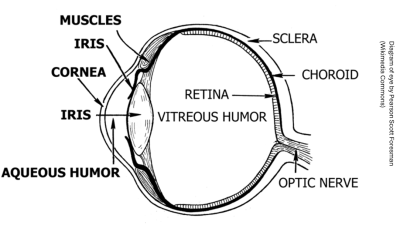About vitreomacular traction (VMT)
The vitreous is a transparent gel-like structure that lies behind the iris (the coloured part of your eye) and lens, and sits in front of the retina. The retina is the light sensing tissue at the back of your eye.
As we get older, our vitreous gel shrinks and naturally separates itself from the retina.
Sometimes the vitreous gel does not separate and instead vitreomacular adhesion takes place. This is when the vitreous gel remains attached to certain areas of the retina. This usually happens at the macula (the area of the retina which is responsible for central vision).
These areas of vitreomacular adhesion can lead to ‘pulling’ of the macula. This pulling force causes a condition called vitreomacular traction (VMT).

How VMT can affect vision
VMT may cause reduced vision or distortion of your vision (where straight lines look bent).
In some people, VMT may cause a macular hole and this can lead to further reduced vision or a central blind spot in the field of vision.
Diagnosing VMT
To diagnose VMT we do the following:
- use eye drops to dilate (widen) your pupils
- perform an optical coherence tomography (OCT) scan. This is non-invasive and uses light energy to produce detailed images of the back of your eye. This allows us to diagnose VMT.
Treatment
In some patients, the vitreous gel eventually separates from the macula and the VMT resolves itself.
Some patients choose not to undergo any treatment if their symptoms do not bother them.
If you continue to have blurry or distorted vision, you may wish to consider treatment to release this pulling force.
There are two treatment options.
Injection of ocriplasmin (Jetrea) into the back of the eye
Ocriplasmin is a synthetic form of an enzyme (protein) that helps the vitreous gel to separate from the macula. It is only suitable for some cases of VMT. We will let you know if this is a suitable option for you.
Ocriplasmin is a once-only treatment and is successful at treating VMT in a third of patients.
If we recommend you have the ocriplasmin injection, we will give you local anaesthetic drops so you do not feel any pain during the injection.
Side effects
Common (and temporary) side effects of the injection include the following:
- slightly sore and gritty eye
- increased eye pressure
- floaters (black dots or lines or swirls that move across your field of vision)
- flashing lights
- yellowing of vision
- reduced vision.
More serious side effects are rare and include the following:
- permanent reduction of vision
- development of a macular hole (a hole in the central part of the retina). We can treat this with surgery.
- retinal detachment. We can treat this with surgery.
- Endophthalmitis (serious infection) causing complete loss of vision (this affects 1 in 1500 patients). We can treat this with oral (by mouth) and topical antibiotics (usually eye drops; sometimes we add ointments). In some cases we use surgery.
If there is no improvement or your symptoms worsen, we will need to consider vitrectomy surgery.
Vitrectomy surgery
Vitrectomy surgery is an operation where we remove the vitreous gel of your eye. We usually perform this procedure while you are sedated under local anaesthetic. (We also give you additional medicine through your vein to help keep you relaxed).
If you do not have treatment for VMT
If we do not treat your VMT, it may improve, stay the same or worsen.
Contact information
Kingston Hospital Royal Eye Unit, Monday to Friday 9am to 5pm
Moorfields at St George's Hospital (Duke Elder Ward), Monday to Friday 4.30pm to 8.30am, 24 hours on weekends. Referral via an emergency GP or booked appointment required.